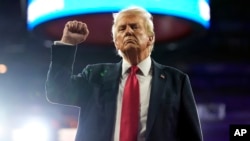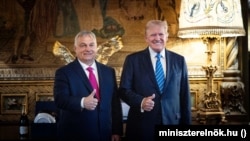Just days before Americans voted in the pivotal November 5 presidential election, Republican candidate Donald Trump donned an orange-and-yellow sanitation worker's safety vest and climbed into a garbage truck at a Wisconsin airport before a throng of reporters.
He was trying to capitalize on a gaffe made a day earlier by President Joe Biden, who called Trump supporters "garbage" while condemning a racist joke made at the Republican candidate's New York City rally.
The message of Trump's political stunt was one that he had been making on the campaign trail since first running for the Republican nomination nearly a decade ago, namely, that the country's political elite looks down upon its citizens.
"You can't be president if you hate the American people," Trump said shortly afterward at a rally, referring to Biden and Democratic nominee Kamala Harris.
Trump's resounding victory in the presidential election this week despite a series of criminal charges and a record two impeachments during his first term from 2017 to 2021 is a testament to how effective his political messaging has been.
He is part of a wave of populist, ring-wing candidates who have pushed aside mainstream parties and ideologies, tapping into the frustration of working-class voters over issues like trade and immigration that mainstream parties have failed to resolve to their satisfaction.
In Hungary, Slovakia, France, Germany, Austria, the Netherlands, and other European states, right-wing populist parties have either come to power or made a strong showing in recent elections.
Hopes that the COVID-19 pandemic would bring an end to the wave of populist victories have been dashed, as the core issues facing Western liberal democracies resurfaced while the virus receded from the front pages.
'Stagnating For Several Decades'
The rise of populism was decades in the making as globalization and the fall of communism hollowed out manufacturing towns, especially in the United States and Eastern Europe, leaving many blue-collar workers behind, Gabor Scheiring, an assistant professor at Georgetown University Qatar who studies populism, told RFE/RL.
"In the United States, there is real suffering among working-class people. Real wages are stagnating, death rates are increasing. In Germany, real wages of workers without a college degree have been stagnating for several decades," he said.
Mass immigration from developing countries in Latin America, Africa, and the Middle East has only added fuel to the political fire, Scheiring says. Populists like Trump have blamed low wages and job loss on competition from immigrants.
Trump made criticism of the Biden administration's open-border policy the focal point of his presidential campaign, promising to deport those who crossed into the United States illegally.
"Donald Trump is indicative of a pattern we have seen in other nations, that is, a turn to the right wing, to a more conservative right-wing government," Robert Spitzer, a political-science professor at the State University of New York in Cortland, told RFE/RL.
"Much of that is driven, I think, by immigration," he said.
Guards at the U.S. southern border have recorded about 8 million encounters during Biden's term through August of this year, a record. Meanwhile, about 400,000 migrants illegally crossed into Europe last year, up almost threefold from the 2020 pandemic lows.
Switching Allegiance
For much of the postwar period, blue-collar workers in the West felt at home in liberal, center-left parties, which championed unions and protected industries.
However, those parties largely joined the euphoric rush to support globalization starting in the 1990s on the bet it would bring greater prosperity to all.
As workers fell behind, especially following the global financial crisis of 2008-09, mainstream parties failed to address their problems.
That gave populists like Trump and Viktor Orban in Hungary an opportunity to present themselves as the real representatives of the people.
"It has been the failure of mainstream parties to represent constituencies, to articulate their needs, and to propose distinct policy solutions that permitted populists to rise," Stanford researchers wrote in a 2020 report analyzing the populist trend.
While populists may differ on the issues they focus on, they offer a similar message to voters: The ruling elite is corrupt and disdainful of the common citizen.
They share a distrust of institutions, including the courts, regulators, and media. Trump has repeatedly called the mainstream media the "enemy of the people" while Orban has largely taken Hungarian media under party control.
Their skepticism of elites and institutions undermined their ability to effectively tackle the COVID-19 crisis, Scheiring says. Trump and Brazil's populist president, Jair Bolsonaro, lost reelection in part due to their handling of the pandemic response, raising hopes of an end to the populist wave.
Blunt Language
Populists also break norms of political behavior and etiquette, using blunt language or trying their hand at manual labor to build trust with workers.
"People feel heard and seen by populists because of these kinds of performative signals," Scheiring said.
Mainstream politicians, on the other hand, talk very differently from the average person, he says, adding that mainstream politics has become the sphere of highly educated people.
"When you distrust the elite, this kind of sociocultural clash resonates and that is why all these populist posturings work so well," he said.











